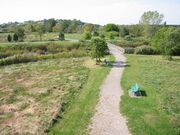⻌
X2ECC ⻌ (Walk0, Shinniou, しんにょう) is Unicode character number 11980, KanjiRadical, WalkU, SIMPLIFIED WALK [1].
⻌ uses 3 bytes: %E2%BB%8C ; 226 187 140 in the decimal representation.
In Japanese, ⻌ can be pronounced しんにょう (Shinniou) and may refer to walk, to continue, to advance, to go, road.
⻌ belongs to WalkU and is easy to confuse with some other characters of this set.

WalkU
WalkU is set of the following five Unicode characters:
X2ECC ⻌ [1], KanjiRadical, Walk0, SIMPLIFIED WALK
X2ECD ⻍ [2], KanjiRadical, Walk1, WALK ONE
X2ECE ⻎ [3], KanjiRadical, Walk2, WALK TWO
X8FB6 辶 [4], KanjiLiberal, Walk3
XFA66 辶 [5], KanjiConfudal, Walk4
The system of names (Walk0,Walk1,Walk2,Walk3,Walk4) is based on the descriptions [2][3][6] of two of these characters by The Unicode Utilities. The similar Kanjis are numbered in the alphabetic order (order of increasing of their Unicode numbers). In word WalkU, the last letter can be interpreted as integer parameter, that can take values 0,1,2,3 or 4.
Characters of WalkU have similar pictures, similar pronunciation (Shinniou, しんにょう) and similar meaning (walk, advance, go on, proceed). For this reason, the linguists do not consider this confusion as a serious problem. Lack of knowledge of these confusion does not affect the exams. The manuals and dictionaries of Japanese do not mention the multitude of ways of encoding of a "well-know" character.
However, the mistakes appear, when one search for the character in databases, or in some document, or tries to replace it through the text, or use the character in the name of a manuscript and then cannot find the file. The problem is not specific for Japanese, and it is so grave, that some authors use only the ascii characters in filenames [7].
The goal of this article is to reveal the confusions with the encoding, in order to avoid mistakes with the similar characters, or, at least, simplify the revealing and the handling, the correction.
In TORI, the primary identification of a character is its Unicode number, not the image. There are serious reasons for such interpretation of Japanese characters. The pictures of Japanese characters are software-dependent, while the Unicode number is, in some sense, "Absolute": in century 21, all the computers understand the Unicode, although, various software show some unicode characters in different ways.
In century 21, the computer support of characters of Japanese is underdeveloped.
Up to year 2021, there is no united standard for the default font, that would allow each character to look the same at various computers, but different from other characters.
Apparently, the opposite cases take place: the character looks different with the default font of different operational systems, but similar to other characters at the same computer. This causes confuses.
Even a native Japanese speaker, watching characters
⻌,
⻍,
⻎,
辶,
辶,
is unlikely to answer:
Which of them is X2ECC?
Which of them is X2ECD?
Which of them is X2ECE?
Which of them is X8FB6?
Which of them is XFA66?
In such a case, the correct specification of the character is "X2ECC ⻌ or X2ECD ⻍ or X2ECE ⻎ or X8FB6 辶 or XFA66 辶"
Term WalkU is defined to substitute this (long and difficult to remember) construction with single word.
Examples
Character ⻌ by itself is not so popular in Japanese, but its image is used in images of other, more complicated canjies. Here are some examples:
X901A 通 通 [8]: Traffic, pass through, avenue, commute, counter for letters, notes, documents
X9023 連 連 [9]: Take along, lead, join, connect, party, gang, clique
X9032 進 進 [10]: continue, move on, Advance, proceed, progress, promote
X9053 道 道 [11]: Road-way, street, district, journey, course, moral, teachings
X9078 選 選 [12]: Elect, select, choose, prefer
The characters above are complicated; they are enlarged in order to allow the visual recognition.
(Over-vice, all of them would look similar to character X2592 ▒.)
Jisho
辶 4 strokes
Variants: 辵
walk, walking, road radical variant (no. 162)
On: チャク
Noun 1. kanji "road" or "advance" radical (radical 162) See also 之繞を掛ける
Other forms 之繞 【しんにゅう】、辶 【しんにょう】、辶 【しんにゅう】、辵 【しんにょう】、辵 【しんにゅう】、⻌ 【しんにょう】、⻌ 【しんにゅう】
辶 walk, walking, road radical variant (no. 162)
Takoboto
Readings
English Noun (futsuumeishi) See also: 之繞を掛ける
kanji "road" or "advance" radical (radical 162)
Kanjis 之 ON: シ KUN: の, これ, ゆく, この of, this
Stroke: 3 JLPT: N1 SKIP: 4-3-4 FC: 3030.0
繞 ON: ジョウ, ニョウ KUN: めぐ.る, まわ.る, もとう.る, まとう surround, return
Stroke: 18 SKIP: 1-6-12 FC: 2491.1
辶 ON: チャク walk, walking, road radical variant (no. 162)
Stroke: 4 SKIP: 2-1-2
辵 ON: チャク walk, walking, road radical (no. 162)
Stroke: 7 SKIP: 2-1-6
辶 ON: チャク walk, walking, road radical variant (no. 162)
Stroke: 4 SKIP: 2-1-2
Radical 162
Both Jisho and Takoboto qualify ⻌ as radical 162
Wikipedia [16] suggests notation Radical 162 only for one kanji, namely 辵; as for ⻍, ⻌, or ⻎, they are qualified as "transforms".
The default media wiki setting does not allow to make difference between terms
Radical 162 and radical 162.
In addition, the confusion may occur with term RADICAL 162, as some operational systems
confuse the lowercase letters and the uppercase ones, while these letters appear in the filenames.
In such a way, term Radical 162, by itself, is confusing; it is difficult to determine, which Unicode characters are qualified as Radical 162 and which do not belong to this set.
Characters X2FA1 ⾡ and X8FB5 辵 appear as synonyms of ⻌ (as well as of other WalkU).
These characters have another pic (it seems to be the same for both X2FA1 and X8FB5), but similar pronunciations and similar meanings.
Tarja
Character ⻌ is highly ambiguous; it is not allowed in Tarja.
Character ⻌ can be translated from Japanese into Tarja in the following ways:
None of these words looks similar to other words of Tarja.
Up to year 2021, there is not enough information collected to make preference in factor of transliteration Shinniou, Shinnyou, Shinnyuu. While, all the three ascii transliterations are kept.
Gallery
References
- ↑ 1.0 1.1 https://util.unicode.org/UnicodeJsps/character.jsp?a=2ECC ⻌ 2ECC CJK RADICAL SIMPLIFIED WALK Han Script id: allowed confuse: 辶 , 辶 , ⻍ ..
- ↑ 2.0 2.1 https://util.unicode.org/UnicodeJsps/character.jsp?a=2ECD ⻍ 2ECD CJK RADICAL WALK ONE Han Script id: allowed confuse: 辶 , 辶 , ⻌ ..
- ↑ 3.0 3.1 https://util.unicode.org/UnicodeJsps/character.jsp?a=2ECE ⻎ 2ECE CJK RADICAL WALK TWO Han Script id: allowed confuse: none ..
- ↑ https://util.unicode.org/UnicodeJsps/character.jsp?a=8FB6 辶 8FB6 CJK UNIFIED IDEOGRAPH-8FB6 Han Script id: restricted confuse: 辶 , ⻌ , ⻍ ..
- ↑ https://util.unicode.org/UnicodeJsps/character.jsp?a=FA66 辶 FA66 CJK COMPATIBILITY IDEOGRAPH-FA66 Han Script id: allowed confuse: 辶 , ⻌ , ⻍ ..
- ↑ https://en.wiktionary.org/wiki/辶 辶 (Redirected from ⻌) Jump to navigationJump to search See also: 辵 and 廴 .. 辶 U+8FB6, 辶 CJK UNIFIED IDEOGRAPH-8FB6 ← 辵 [U+8FB5] CJK Unified Ideographs 辷 → [U+8FB7] // ⻌ U+2ECC, ⻌ CJK RADICAL SIMPLIFIED WALK ← ⻋ [U+2ECB] CJK Radicals Supplement ⻍ → [U+2ECD] // ⻍ U+2ECD, ⻍ CJK RADICAL WALK ONE ← ⻌ // [U+2ECC] CJK Radicals Supplement ⻎ → [U+2ECE] ⻎ U+2ECE, ⻎ CJK RADICAL WALK TWO ← ⻍ [U+2ECD] CJK Radicals Supplement ⻏ → [U+2ECF] // 辶 U+FA66, 辶 CJK COMPATIBILITY IDEOGRAPH-FA66 ← 贈 [U+FA65] CJK Compatibility Ideographs ..
- ↑ https://coderoad.ru/588967/Имена-файлов-содержащие-не-ascii-символов-международного-языка Имена файлов, содержащие не ascii символов международного языка // У кого-нибудь был опыт создания файлов с именами файлов, содержащими символы не ascii международного языка? // Легко ли это сделать, или это чревато опасностью? // Ожидается ли эта функциональность от японско - китайскоязычных веб-пользователей? // Должны ли расширения файлов также быть символами международного языка? // Информация: в настоящее время мы поддерживаем многоязычие на нашем сайте, но наши имена файлов всегда ASCII. Мы используем ASP.NET на фреймворке .NET. Это было бы использовано в сценарии, где международные пользователи могли бы выбрать общий формат и имя для своих файлов. // nick_alot, 26 февраля 2009 в 03:21
- ↑ https://www.nihongo-pro.com/kanji-pal/kanji/通 通 10 strokes READINGS KUN 訓 とおる とおり とおす とおし かよう ON 音 ツウ ツ STROKE ORDER Stop Pause Previous Stroke Next Stroke Slow Fast Animation data provided by KanjiVG Look up a kanji: Report an issue on this page JLPT Level: JLPT N4 (upper beginner level) Kanken Level: Kanken Level 9 (completion of 2nd grade) Grade: Taught during the 2nd grade in Japan Radical: ⻍(⻌) Radical name: しんにょう Meaning: Traffic, pass through, avenue, commute, counter for letters, notes, documents, etc.
- ↑ https://www.nihongo-pro.com/kanji-pal/kanji/連 JLPT Level: JLPT N3 (lower intermediate level) Kanken Level: Kanken Level 7 (completion of 4th grade) Grade: Taught during the 4th grade in Japan Radical: ⻍(⻌) Radical name: しんにょう Meaning: Take along, lead, join, connect, party, gang, clique Usage: Appears very frequently in Japanese newspapers; only about 30 kanji are used more often.
- ↑ https://www.nihongo-pro.com/kanji-pal/kanji/進 進 11 strokes READINGS KUN 訓 すすむ すすめる ON 音 シン STROKE ORDER Stop Pause Previous Stroke Next Stroke Slow Fast Animation data provided by KanjiVG Look up a kanji: Report an issue on this page JLPT Level: JLPT N3 (lower intermediate level) Kanken Level: Kanken Level 8 (completion of 3rd grade) Grade: Taught during the 3rd grade in Japan Radical: ⻍(⻌) Radical name: しんにょう Meaning: Advance, proceed, progress, promote Usage: Appears very frequently in Japanese newspapers; only about 150 kanji are used more often.
- ↑ 道 12 strokes READINGS KUN 訓 みち ON 音 ドウ トウ STROKE ORDER Stop Pause Previous Stroke Next Stroke Slow Fast Animation data provided by KanjiVG Look up a kanji: Report an issue on this page JLPT Level: JLPT N4 (upper beginner level) Kanken Level: Kanken Level 9 (completion of 2nd grade) Grade: Taught during the 2nd grade in Japan Radical: ⻍(⻌) Radical name: しんにょう Meaning: Road-way, street, district, journey, course, moral, teachings Usage: Appears very frequently in Japanese newspapers; only about 200 kanji are used more often.
- ↑ https://www.nihongo-pro.com/kanji-pal/kanji/選 選 15 strokes JLPT Level: JLPT N3 (lower intermediate level) Kanken Level: Kanken Level 7 (completion of 4th grade) Grade: Taught during the 4th grade in Japan Radical: ⻍(⻌) Radical name: しんにょう Meaning: Elect, select, choose, prefer Usage: Appears very frequently in Japanese newspapers; only about 60 kanji are used more often.
- ↑ https://jisho.org/search/%E8%BE%B6%20%23kanji 辶 4 strokes Radical: walk 辵 (辶, ⻌, ⻍) Parts: Variants: 辵 walk, walking, road radical variant (no. 162) On: チャク
- ↑ https://jisho.org/search/%E8%BE%B6 Words — 1 found しんにょう 之繞 Links Noun 1. kanji "road" or "advance" radical (radical 162)See also 之繞を掛ける Other forms 之繞 【しんにゅう】、辶 【しんにょう】、辶 【しんにゅう】、辵 【しんにょう】、辵 【しんにゅう】、⻌ 【しんにょう】、⻌ 【しんにゅう】 Details ▸ Kanji — 1 found 4 strokes. 辶 walk, walking, road radical variant (no. 162) On: チャク
- ↑ https://takoboto.jp/?w=1884150 之繞 辶 辵 ⻌ Readings しんにょう shinnyou しんにゅう shinnyuu English Noun (futsuumeishi) See also: 之繞を掛ける kanji "road" or "advance" radical (radical 162) Kanjis 之 ON: シ KUN: の, これ, ゆく, この of, this Stroke: 3 JLPT: N1 SKIP: 4-3-4 FC: 3030.0 繞 ON: ジョウ, ニョウ KUN: めぐ.る, まわ.る, もとう.る, まとう surround, return Stroke: 18 SKIP: 1-6-12 FC: 2491.1 辶 ON: チャク walk, walking, road radical variant (no. 162) Stroke: 4 SKIP: 2-1-2 辵 ON: チャク walk, walking, road radical (no. 162) Stroke: 7 SKIP: 2-1-6 辶 ON: チャク walk, walking, road radical variant (no. 162) Stroke: 4 SKIP: 2-1-2
- ↑ https://en.wikipedia.org/wiki/Radical_162 Radical 162 or radical walk (辵部) meaning "walk" is one of the 20 Kangxi radicals (214 radicals in total) composed of 7 strokes. When used as a component, this radical character transforms into ⻍, ⻌, or ⻎ (See #Variant forms). In the Kangxi Dictionary, there are 381 characters (out of 49,030) to be found under this radical. 辶 (3 strokes), the component form of 辵, is also the 49th indexing component in the Table of Indexing Chinese Character Components predominantly adopted by Simplified Chinese dictionaries published in mainland China, with 辵 listed as its associated indexing component.




















